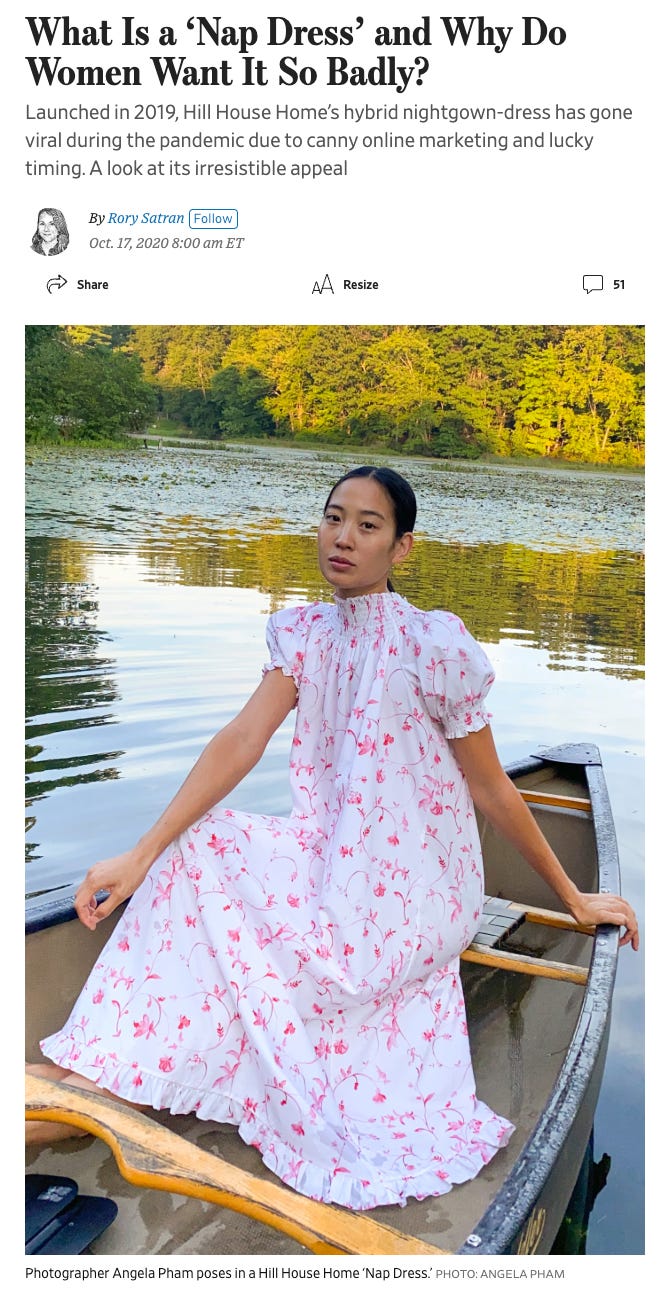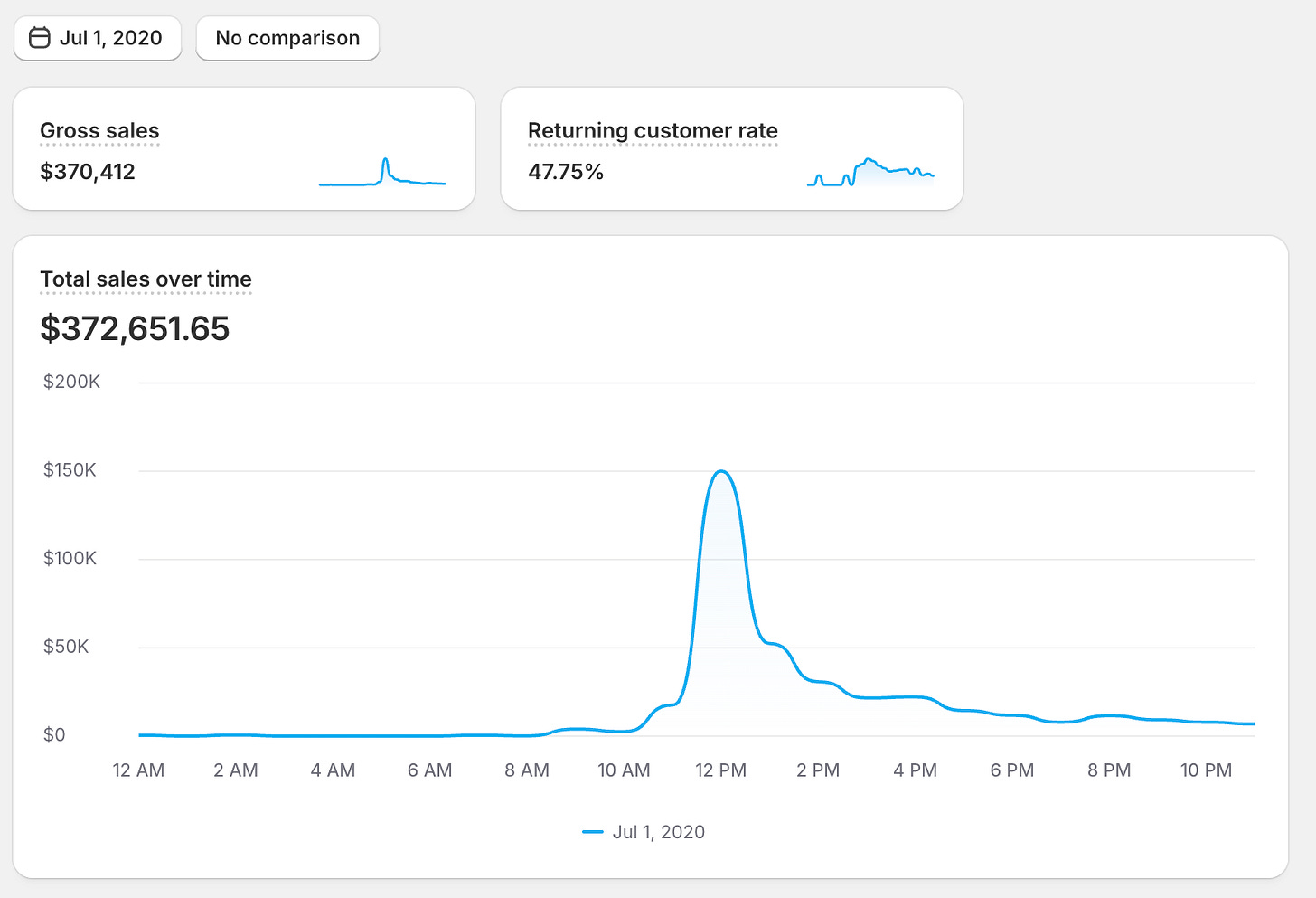We called it Nap Dress Summer: our biggest launch yet.
It was the summer of 2021, and our small team was energized and excited. We’d gone from a tiny New York home store to an if-you-know-you-know rising fashion brand. It felt like we had a little secret with our tight-knit community: a magical product we called the Nap Dress that made you look snatched, felt comfortable, and could be worn to anything.
About 9 months earlier, I’d sat in the window of my New York City bedroom, heavily pregnant with twins, and screamed when I spotted a stranger on the street wearing one of our dresses. It was the first time I’d ever seen our creations in the wild. Since that moment, everything had been electric. I’d given birth to my sweet twins in an Upper East Side hospital bed as a Wall Street Journal editor hit publish on a major brand profile. It felt like the years of hard, quiet work—five people in a co-working space, screaming into the void—were beginning to pay off.
When it came time to place our buy for June 2021, we felt confident enough to place our largest order yet. It was a huge bet—by far the most inventory we’d ever committed to. I never realized, before working in fashion, just how early those bets have to be placed. In January, we wired massive 50% down payments in cash to secure enough product for our most important season, summer. It felt terrifying and thrilling all at once. What if we couldn’t sell it all? What if we’d overestimated demand? But we kept coming back to the same thing we always said in moments like this: let’s hold hands on this. None of us knew if it would work—but we all agreed we had to try.
A week before launch, we got word that a few styles were delayed in transit. At that point, we weren’t a big enough company to book full shipping containers. We had to ship LCL—“less than container load”—which meant our product shared space with goods from other companies as it crossed the ocean. It also meant we didn’t control the container. If someone else’s shipment ran into customs issues, the entire container could be held up—including ours.
Nine of our styles were affected by the delay, stuck in a container on a boat floating somewhere across the ocean. I remember sitting on an hours-long zoom call with our team, mapping out international trade routes, laughing as we wondered aloud, “what if we just, like, parachute onto the boat and say, “Hi, we’re here about the Nap Dress?”
In the absence of parachutes, we decided to pre-order the affected dresses, adding a note on our PDP that items would ship in two weeks, the time frame communicated to us by our freight forwarders. We figured this was totally manageable, as long as we set expectations clearly with our customers.
And then, the drop. June 16, 2021. For days I had felt physically ill with nerves. I scrolled through my camera roll from that month to write this post and the weeks prior are littered with mermaids: endless fabric close-ups in different light, try-ons in my bedroom mirror, late night zoom sessions. I remember feeling so out-of-control: our entire bank account was floating on the ocean toward our New Jersey warehouse. If I just posted enough try-ons, enough pictures in the perfect light, enough analysis in Excel – maybe everything would work out?
I’ve never experienced anything in business like that day. We launched the collection at 12 ET, and by midnight we had done $4.2 million in revenue. All on our direct website. At around 2PM, our paid media agency called us and apologized, telling us that our dashboard was clearly malfunctioning: there was no possible way we could have done that much revenue in one day. We couldn’t believe it either —- it was an out-of-body experience for much of our tiny team of less than ten. The previous year, we’d done $320,000 in revenue on drop day: a 1213% increase year-over-year. I walked around in a daze all day, fell asleep dreaming about the Shopify dashboard I’d been staring at for hours. I couldn’t believe people liked our dresses the way I did.
And then came the Bad Luck Boat.
In the midst of the chaos of launch week, we realized just how many of the delayed, pre-order dresses we’d sold. At first, we felt relieved—at least we’d clearly stated on the product page that these styles would ship in two weeks. But then two things happened: First, we started hearing from customers who hadn’t noticed the pre-order message. And second, the boat got delayed again—this time, with no clear explanation. The new estimate was four weeks from launch day, up from two.
The good news was that this issue affected only a small percentage of total orders (I tried to track down the exact number, but couldn’t find the data). Still – these were real customers, with real plans. People had bought these dresses for birthdays, graduations, parties, trips. We felt deeply connected to our community, and we were panicked about the delay. It was enough stress to (almost) erase the excitement of our record-breaking day.
We huddled as a team and asked ourselves: How would we want this handled if we were the customer? We landed on three things. First, total transparency. Second, the option for an immediate refund. And third—if possible—an alternative: a way to still get something beautiful in time for the event.
Once we made the decision, we got to work emailing every single affected customer proactively. I remember it so clearly—huddled on my TV room couch, on Zoom with the rest of the team. We split up order numbers and all logged into our customer service inbox. At the time, we were still running CX through Gmail and had no way to mass email a group like this. It was all completely manual.
Meanwhile, our customer service volume had spiked 400%, and our SLAs stretched from 1 business day to 3–5. It felt like a nightmare—every time we answered an email, another one popped up. We didn’t have the systems or tools we have now to manage CX at scale. Some customers were angry, others were incredibly kind. I remember receiving a DM on my personal account from a customer whose order was delayed; “Your company,” she told me, “Is a disgrace.” We were completely overwhelmed.
And we learned a lot.
As a rule, we just don’t have the stomach for pre-order at Hill House—unless the product is physically in our warehouse. It’s our own risk appetite, and we know that now. We’d rather lose the revenue than spend a month panicking over something totally out of our control, imagining how we might rescue dresses from a ship in the middle of the sea.
What we do believe in—what this experience really reinforced for us—is that accountability and transparency are everything when it comes to customer communication. We should have made the pre-order more clear on the product page, and we should have given a larger buffer as a time estimate. As a whole, our customers were incredibly kind and understanding. The Bad Luck Boat became an inside joke that some of our OG followers still comment about on our posts. It felt like we’d earned a kind of trust—and I don’t take that lightly.
There’s something strange about how frictionless e-commerce is supposed to feel. You click a button, a package appears. There’s an expectation of instant resolution—of invisible systems working perfectly in the background. But the truth is, there are human hands behind every part of it. Someone drew, cut, and sewed that dress. Someone unpacked it, inspected it, folded it, wrapped it, boxed it, labeled it, shipped it. Someone loaded it onto a container, saw it through customs. Someone panicked over it. Wrote an email about it. Stayed up late fixing it. The process is physical. It’s emotional. It’s human.
But those things aren’t foolproof. I wasn’t used to people being angry and mean in this way until I worked in retail. It’s one of the reasons working retail is so important to me—it’s a crucial life skill to be able to maintain your composure and your humanity when people are treating you as anything but.
And yes, I remember every single mean comment. They all live on my Billy Madison lipstick list.
We didn’t have a Plan B. Just a team, a Gmail inbox, and a belief that if we treated our customers like part of the story, they might treat us like people too.
And they did.
What I still think about is how close it all was. The $4.2 million day, and the sick feeling in my stomach when the boat didn’t move. Growth didn’t make things smoother, it just made everything matter more.
We didn’t have perfect systems. We didn’t have a playbook. We had instinct, some spreadsheets, and a group of people who cared enough to figure it out in real time.










That mermaid print from summer 21 is still one of my favorites and my biggest regret not buying for myself! My girls have outgrown theirs now and here I am, still thinking about it 🧜🏽♀️
I love hearing this behind-the-scenes story! I remember the excitement surrounding this drop, and still love so many of my pieces from it. The Desk Sweater and Lucky Scarf are underrated styles!